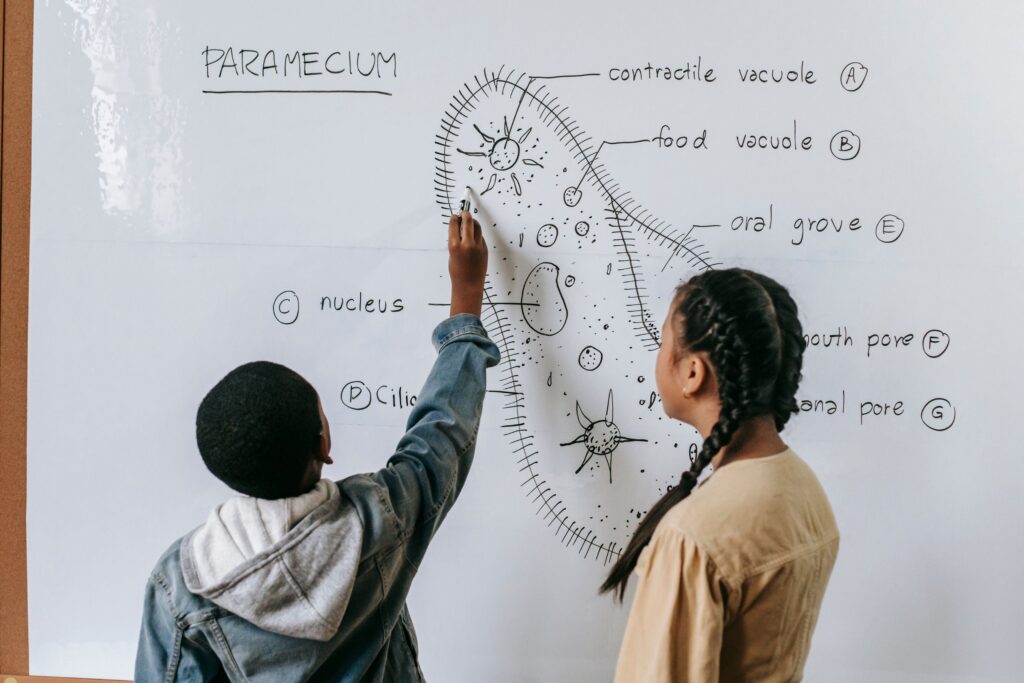
GCSE Biology 2025: The Ultimate Study Guide
This study guide is designed to help you master GCSE Biology for the 2025 exams. It covers key topics, provides essential definitions, and includes useful tips for revision and exam success.
1. Cell Biology
The Cell Structure
- Prokaryotic vs Eukaryotic Cells:
- Prokaryotic cells (e.g., bacteria) have no nucleus; DNA is in the cytoplasm.
- Eukaryotic cells (e.g., animal and plant cells) have a nucleus containing DNA.
- Cell Organelles and Functions:
- Nucleus – Controls cell activities, contains DNA.
- Cytoplasm – Site of chemical reactions.
- Cell membrane – Controls substance movement in/out of the cell.
- Mitochondria – Site of aerobic respiration, energy release.
- Ribosomes – Protein synthesis.
- Cell wall (plants only) – Provides support.
- Chloroplasts (plants only) – Site of photosynthesis, contains chlorophyll.
- Vacuole (plants only) – Stores cell sap, maintains pressure.
Learn about Anaerobic Respiration in Plants and Fungi
Microscopy
- Light Microscope: Uses light and lenses to magnify images of cells.
- Electron Microscope: Provides higher magnification and resolution.
Cell Division
- Mitosis: Produces two identical daughter cells for growth and repair.
- Meiosis: Produces four genetically different gametes for reproduction.
2. Organisation
Levels of Organisation
- Cells → Tissues → Organs → Organ Systems → Organism
The Digestive System
- Key organs: Mouth, oesophagus, stomach, small intestine, large intestine, liver, pancreas.
- Enzymes:
- Amylase – Breaks down starch into sugars.
- Protease – Breaks down proteins into amino acids.
- Lipase – Breaks down fats into fatty acids and glycerol.
The Circulatory System
- Heart Structure: Left and right atria, left and right ventricles, valves.
- Blood Components:
- Red blood cells – Carry oxygen using haemoglobin.
- White blood cells – Defend against infection.
- Platelets – Help blood clotting.
- Plasma – Transports nutrients and waste.

3. Infection and Response
Pathogens and Disease
- Types of pathogens: Bacteria, viruses, fungi, protists.
- Examples of diseases:
- Bacteria – Salmonella (food poisoning).
- Viruses – Measles, HIV.
- Fungi – Athlete’s foot.
- Protists – Malaria.
Immune System and Vaccination
- White blood cells produce antibodies and engulf pathogens.
- Vaccinations introduce weakened pathogens to stimulate an immune response. Algebra Guide for KS3 Students
4. Bioenergetics
Photosynthesis
Equation:
Carbon dioxide+Water→LightGlucose+Oxygen\text{Carbon dioxide} + \text{Water} \xrightarrow{\text{Light}} \text{Glucose} + \text{Oxygen}
- Factors affecting photosynthesis: Light intensity, CO₂ concentration, temperature.
Respiration
- Aerobic respiration (with oxygen): Glucose+Oxygen→Carbon dioxide+Water+Energy\text{Glucose} + \text{Oxygen} \rightarrow \text{Carbon dioxide} + \text{Water} + \text{Energy}
- Anaerobic respiration (without oxygen, less energy released):
- In animals: Glucose → Lactic acid + Energy.
- In plants: Glucose → Ethanol + Carbon dioxide + Energy.
5. Homeostasis and Response
Nervous System
- Reflex Arc: Stimulus → Receptor → Sensory Neuron → Relay Neuron → Motor Neuron → Effector → Response.
Hormonal Control
- Key hormones:
- Insulin (regulates blood sugar).
- Adrenaline (fight or flight).
- Oestrogen and testosterone (reproductive hormones).
6. Inheritance, Variation, and Evolution
DNA and Genetics
- DNA carries genetic information.
- Chromosomes: Humans have 46 chromosomes (23 pairs).
- Genes: Sections of DNA coding for proteins.
Evolution and Natural Selection
- Charles Darwin’s Theory: Survival of the fittest leads to evolution.
7. Ecology
Ecosystems
- Biotic (living) and Abiotic (non-living) factors affect organisms.
- Food chains and trophic levels:
- Producer → Primary Consumer → Secondary Consumer → Tertiary Consumer.
Biodiversity and Human Impact
- Deforestation, pollution, and climate change impact ecosystems.
Exam Tips
Use past papers – Practice answering questions under timed conditions.
Make flashcards – For key definitions and processes.
Create mind maps – Summarise information visually.
Use mnemonics – E.g., “MRS GREN” (Movement, Respiration, Sensitivity, Growth, Reproduction, Excretion, Nutrition).
Teach someone else – Helps reinforce your understanding.
Final Words
Stay consistent with your revision, practice regularly, and remember to take breaks. Good luck with your GCSE Biology exam! Let’s connect to get prepared with the best tutors – Online tutoring UK
